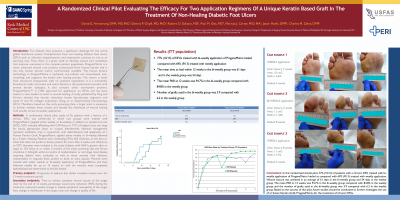Clinical Research
(CR-067) Multi-center, Randomized Clinical Trial Evaluating the Efficacy of Two Application Regimens of a Unique Keratin-based Graft in the Treatment of Non-Healing Diabetic Foot Ulcers.

Diabetic Foot Ulcers(DFUs) are a major burden on healthcare systems and on patients. They require continuous long-term care, multiple treatments, frequent visits, and there is a myriad of different treatment modalities, all varying in results and efficacy. To treat these non-healing complicated and multifactorial wounds, a novel advanced graft constructed from human keratin was created. In this trial this unique graft was used to treat recalcitrant non healing DFUs.
Methods: 26 patients were enrolled in a two arm randomized controlled trial. Wagner Grade 1 and 2 DFUs that were non-healing for at least 4 weeks, with adequate blood flow and were void of clinical infection or osteomyelitis were entered into 2 weeks of screening. Patients with an HbA1c greater than or equal to 13% or a serum creatinine greater than or equal to 3.0 mg/dL were excluded. Those that met all the qualifications were randomized to receive either weekly or bi-weekly application of the human keratin graft. Both groups were followed for 12 weeks. The primary study endpoint was healing at 12 weeks and the secondary endpoints included percent area reduction and time to heal.
Results:
At 12 weeks for the intent to treat population (ITT) weekly application healed 9/13 DFUs (69%) and biweekly application healed 10/13 (77%). Furthermore for percent area reduction over 12 weeks, the ITT population for weekly application showed a mean reduction of 84.8%;(SD: 28.68) and biweekly application 94.7%(SD: 11.04) . In regard to the ITT population for mean time to healing, subjects receiving weekly application healed in 54 days(95% CI: 38.2-69.7) with biweekly healing in 61 days(95% CI: 52.1-70.4)
Discussion:
Both weekly and biweekly application of this novel keratin graft healed a large percentage of refractory diabetic foot wounds. Due to the durability of this unique keratin graft, whether used weekly or biweekly there was no statistical difference in healing percentage, wound reduction or time heal in either group. Therefore, this graft should be considered in the treatment regimen for non healing diabetic foot wounds. Further evaluation is warranted to validate these promising findings.

.jpeg)